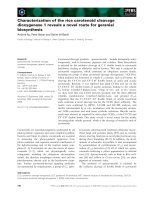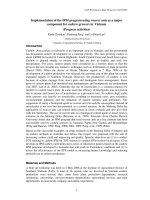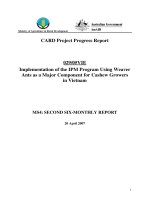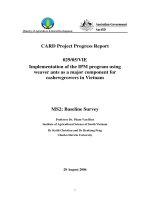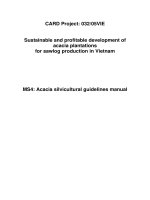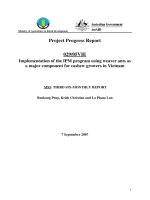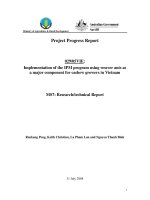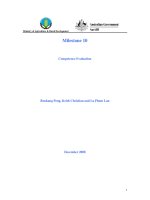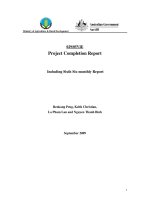Card Project VIE: Implementation of the IPM Program Using Weaver Ants as a Major Component for Cashew Growers in Vietnam - MS4" pdf
Bạn đang xem bản rút gọn của tài liệu. Xem và tải ngay bản đầy đủ của tài liệu tại đây (95.24 KB, 12 trang )
Ministry of Agriculture & Rural Development
CARD Project Progress Report
029/05VIE
Implementation of the IPM Program Using Weaver
Ants as a Major Component for Cashew Growers
in Vietnam
MS4: SECOND SIX-MONTHLY REPORT
20 April 2007
1
1. Institute Information
Project Name
Implementation of the IPM program using weaver
ants as a major component for cashew growers in
Vietnam
Vietnamese Institution
Institute of Agricultural Science of South Vietnam
Vietnamese Project Team Leader
Mr La Pham Lan
Australian Organisation
Charles Darwin University
Australian Personnel
Dr Keith Christian and Dr Renkang Peng
Date commenced
February 2006
Completion date (original)
January 2009
Completion date (revised)
Reporting period
September 2006 - February 2007
Contact Officer(s)
In Australia: Team Leader
Name:
Keith Christian
Telephone:
61 8 89466706
Position:
Associate Professor
Fax:
61 8 89466847
Organisation
Charles Darwin
University
Email:
In Australia: Administrative contact
Name:
Jenny Carter
Telephone:
61 08 89466708
Position:
Research Manager
Fax:
61 8 89467199
Organisation
Charles Darwin University
Email:
In Vietnam
Name:
La Pham Lan
Telephone:
84 0913829560
Position:
Head of Plant Protection
Department
Fax:
84 8 8297650
Organisation
Institute of Agricultural
Science of South Vietnam
Email:
2
2. Project Abstract
Cashew is a very important crop in Vietnam, and the government has designated cashew
development as a national priority. Productivity of cashew has increased since 2002, but the
extensive use of pesticides has caused health problems to farmers, their animals and the
environment. The cashew IPM program using weaver ants as a key component developed at
Charles Darwin University (CDU) does not use toxic insecticides, but results in high yield.
This project is to use the CDU cashew IPM to develop and implement a cashew IPM program
that will work under Vietnamese conditions. The proposed activities of the second 6 months
have been achieved. The TOT training at two training centres has been operating successfully.
A total of 12 courses were delivered in the TOT training. Weaver ant technology has been
successfully transferred to IAS project staff and TOT trainees by CDU project staff. The IPM
curriculum development has been conducted smoothly. Seventy photos have been obtained
for the preparation of cashew IPM posters. CDU has made another commitment towards this
project by offering a Ph.D. scholarship to an IAS staff member for a period of three years to
work on a project related to this cashew IPM program.
3. Executive Summary
The proposed activities for the second 6 months of the project have been achieved.
The following are the achievements against each of the activities.
The first year TOT training has been progressing well since the start of the project.
The September training took place from 25 September to 2
nd
October. Due to TOT
trainees’ heavy commitment to the brown leaf hopper control (MARD first priority),
the November training in 2006 was combined with January training in 2007, and this
combined training was conducted from 29 January – 10 February 2007. A total of 12
courses were delivered in the TOT training, and they include the following 7 aspects:
the main cashew insect pests and their control, the main cashew diseases and their
management, the natural enemies in cashew orchards, the use of weaver ants in
cashew orchards, the IPM principles, appropriate use of pesticides in the IPM systems
and cashew cultivation. Under the supervision of master trainers, and using their own
observations, assessments and practice in the IPM plots, trainees have fully
understood the mechanism of weaver ants in controlling the major insect pests and
how to use the ants in cashew orchards. To extensively use local knowledge about
weaver ants, an experienced citrus farmer was invited to give a talk to our TOT
trainees.
The weaver ant technology has been successfully transferred to IAS project staff and
TOT trainees by CDU project staff. A total of 14 weaver ant colonies were established
and maintained in our two demonstration orchards. During the instalment of the
weaver ant colonies, we successfully used local knowledge to resolve the problems
caused by competitive species of other ants. During the harvest time, it was noticed
that cashew nuts produced in the IPM plot were shiny and cleaner than the nuts
produced in the farmer managed plot. The orchard owners in Binh Phuoc province are
happy with this IPM program.
3
The IPM curriculum development has been conducted smoothly. It has concentrated
on the data collection from field surveys and regular monitoring of the demonstration
orchards. We have also collected sufficient data from field observations and
laboratory rearing for several chapters of the cashew IPM curriculum.
During this reporting period, a total of 70 photos have been obtained for the
preparation of cashew IPM posters. These photos include insect pests, natural
enemies, weaver ant behaviour, weaver ant colony transplantation and their
management and the control of competitive species of ants in cashew orchards.
Because of the positive influence of this project in Vietnam, Charles Darwin
University has made another commitment towards this project by offering a Ph.D.
scholarship to an IAS staff member for a period of three years to work under this
cashew IPM program.
Mr La Pham Lan has been nominated as the project leader in charge of Vietnamese
personnel and expenses of the project because the former project leader, Dr Pham Van
Bien, retired in November 2006.
The progress of the current TOT training is attached at the end of this report.
4. Introduction & Background
The aims of this project are to increase cashew yield and improve nut quality. Specific
objectives are (1) to conduct TOT training in cashew IPM for TOT trainers to conduct
FFSs in their local region, (2) to develop an IPM cashew curriculum and a series of
illustrative posters that will work in Vietnamese conditions based on the cashew IPM
programs developed in Australia and (3) to assess the effectiveness of the FFS model
in increasing farmer knowledge and reducing pesticide use in cashew production.
The project expects to result in 120 TOT cashew IPM trainers from eight major
cashew growing provinces and 3750 cashew farmers educated in cashew FFSs. A
practical guide for cashew IPM and a series of illustrative posters will be developed.
The effectiveness of FFS in enhancing farmer knowledge in cashew cultivation will
be assessed.
The project will concentrate on (1) the use of the farmer participatory training and
research program, involving TOT and FFSs and (2) the development of a cashew IPM
curriculum and illustrative posters based on field monitoring, observations and
experiments by field experimentalists, TOT trainees and FFS participants.
The implementation methods include establishment of demonstration orchards for
TOT courses, the TOT and FFS training, the development of a cashew IPM
curriculum and IPM posters, and the community baseline surveys. A total of 8 major
cashew-growing provinces, which have 300,700 ha of cashew, accounting for 86% of
the total cashew areas in Vietnam will be targeted.
5. Progress to Date
Based on our logframe, this report will cover activities I, III and IV of our project
proposal. The following is the progress against each of the proposed activities.
4
5.1 Implementation Highlights
Activity I has three aspects: I(i), I(ii) and I(iii). I (i) Identification of regions within
each of the 6 participating provinces to be targeted for the program and I (ii) Selection
of IPM trainers from each targeted region to undertake TOT training in cashew IPM
have been previously reported (see the First Six-monthly Report for detail).
I (iii) TOT training in cashew IPM undertaken
During this reporting period from August 2006 to February 2007, we planned three
TOT training periods: (1) 13 – 19 September 2006 (September training), (2) 24
November – 2 December 2006 (November – December training) and (3) 10 – 16
January 2007 (January training). However, the brown leafhopper was in outbreak in
rice fields, threatening the Vietnamese national rice production. The government of
Vietnam considered this issue as a top priority for every provincial Sub-PPD. All our
TOT trainees were heavily involved in this campaign between September 2006 and
January 2007. This resulted in a delay of our TOT training. The September training
was delayed for two weeks, and it took place from 25 September to 1
st
October 2006.
The November - December training was combined with the January training
(combined January TOT training), and it was conducted from 29 January – 9 February
2007. This report will address September TOT training, the combined January TOT
training, the establishment of weaver ant colonies in demonstration orchards and
progress of the cashew IPM curriculum and posters.
(1) September TOT training
The September TOT training was conducted from 25 September to 1
st
October 2006
in Dong Nai training centre and from 26 September to 2 October 2006 in Binh Phuoc
training centre. This training occurred during the period of cashew tree monsoon
flush, and so, the training concentrated on cashew variety selection, suitable use of
fertilizers, insecticide use in IPM systems, cashew diseases and their control
strategies, and weaver ants and other natural enemies in cashew orchards. The courses
we delivered are tabulated in Table 1. Trainees were interested in the courses and
practicals. They were also satisfied with our training methods (see Appendix 1).
(2) The combined January TOT training
This TOT training was conducted from 29 January – 9 February 2007 in Dong Nai
training centre and from 30 January – 10 February 2007 in Binh Phuoc training
centre, and it occurred during late flowering and fruit setting. The training mostly
concentrated on the biology of weaver ants, how to use weaver ant colonies in cashew
orchards, the problems of using weaver ants and their solutions and the main cashew
insect pests and diseases. The courses we delivered are listed in Table 2. Trainees
were interested in courses and practicals (see Appendix 1). Under the supervision of
master trainers, TOT trainees have fully understood the mechanism of weaver ants to
control the major insect pests in cashew orchards and the use of the weaver ant
technology. This was accomplished by their own observations, their own practice and
their own assessment of the major insect pest damage between the IPM plots and the
farmers’ plots.
5
(3) Establishment of weaver ant colonies in demonstration orchards
During the cashew pre-flowering flush, which was the best time to transplant weaver
ant colonies into cashew IPM plots, Dr Peng went to Vietnam on 20 November in
order to transfer the weaver ant technology to TOT trainees in the November-
December TOT training. Because the TOT trainees in each provincial Sub-PPD were
heavily involved in controlling brown leafhoppers in rice fields during that period, the
November – December TOT training was forced to be delayed. Therefore, Dr Peng
had to transfer the weaver ant technology to key project staff in the IAS and
demonstration orchard owners by working with them as a group. Staff who
participated in the transplantation of weaver ant colonies are listed in Table 3. Later
IAS staff demonstrated this ant technology to TOT trainees in the January TOT
training, and the trainees had plenty of time to practice with it. The whole
implementation of the weaver ant technology included (1) the identification of ants on
each tree in the IPM plots, (2) baiting of competitive ant species, (3) Determination of
weaver ant colonies, (4) Transplantation of weaver ant colonies, (5) grouping trees
together to receive the transplanted ant colonies, and (6) the management of the ant
colonies in the IPM plots.
Identification of ants on each tree in the IPM plots
Due to regular use of insecticides, no weaver ants were found in the two IPM plots,
but several species of other ants were identified as being weaver ant competitors. The
major competitive ant at the Binh Phuoc IPM plot was the crazy ant, Anoplolepis
gracilipes, which was very abundant, occupying every tree. The main species of
competitive ants in Dong Nai IPM plot were the crematogaster ant, Crematogaster sp.
with large numbers occupying one third of the trees in the IPM plot, and the small
black ant, Tapinoma melanocephalum, that was abundant on the remaining trees of
the plot.
Baiting of competitive ant species
Ant baits (Amdro and Campaign ant bait) brought from Australia were tried on these
ants with several different medium, but they did not work on these ants. At the Binh
Phuoc site, through detailed examination of crazy ant behaviour, it was found that
almost all the ant nests were build in the fallen leaves close to the bare soil. In order to
reduce the size of the large populations of crazy ants, we raked fallen leaves under
each tree base to expose the ant nests and simultaneously sprayed with a contact-
killing insecticide (Motox® 5EC ). This operation was repeated the next day on the
tree base for some trees where crazy ant nests were not found in the first operation.
After the two days, the crazy ant populations were eradicated from the cashew trees,
and weaver ant colonies were transplanted into the plot eight days later. At the Dong
Nai site, the Crematogaster ants were nesting on cashew tree branches, and the small
black ant were nesting underground at or near tree base. The contact-killing
insecticide was not effective in controlling these two species of ants. After we
consulted local farmers and insecticide shop assistants, we were told that minced fresh
fish meat mixed with Regent® (Fipronil) powder is effective in controlling many
species of ants. Therefore, we tried this bait (minced buck mackerel (500g) mixed
with Regent® powder (0.8g)). We found that this bait was very attractive to these two
species of ants. Examination of the ant nests the next day showed that almost all the
6
crematogaster ants were dead in their nests, including queen ants, and that the small
black ant activity was greatly reduced. Seven days later after this baiting, weaver ant
colonies were transplanted into this plot.
Determination of weaver ant colonies
Because weaver ants are very susceptible to toxic insecticides and because
insecticides have been extensively used in cashew growing areas, we had difficulty
finding weaver ant colonies near the demonstration orchards. After extensive
searching, we successfully located enough weaver ant colonies in the suburb of Dong
Xoai Town, Binh Phuoc province and in the residential area of Trang Bom Town,
Dong Nai province where insecticides were rarely or never used. A total of 13
colonies in Binh Phuoc and 17 colonies in Dong Nai were identified (Table 4). The
procedures of identifying the ant colonies will be described in detail in the IPM
curriculum.
Transplantation of weaver ant colonies
Of the 13 colonies identified at Dong Xoai Town, Binh Phuoc province, 7 were
collected and transported to the Binh Phuoc demonstration orchard. Of the 17 weaver
ant colonies identified in the residential area of Trang Bom Town, Dong Nai province,
7 were transplanted to the Dong Nai demonstration orchard. Collecting methods and
facilities needed for weaver ant collection will be described in detail in the IPM
curriculum.
Grouping trees together to receive the transplanted ant colonies
Based on the size of the collected weaver ant colonies, trees in the Binh Phuoc IPM
plot were grouped into 7 groups. The number of trees in each group varied from 4 to
9, and the average number of trees was 6.7 per group. Each group of trees received
only one weaver ant colony. Trees within a group were linked by polystrings to
promote ant activity if the side branches were not attached to each other. The
boundary between the groups of trees was kept clear by pruning attached side
branches between trees to prevent fighting between weaver ant colonies.
Trees in the Dong Nai IPM plot were also grouped into 7 groups. The number
of trees in each group varied from 6 to 12 based on the size of collected weaver ant
colonies, and the average number of trees was 8.6 per group. A total of 7 colonies
were installed, and the management of trees within each group and between groups
was the same as in the Binh Phuoc IPM plot (see above).
Management of the weaver ant colonies in the IPM plots
After weaver ant colonies were transplanted into the IPM plots, instructions for
weaver ant colony monitoring and management were provided to IAS project staff for
the maintenance of the ants in IPM plots.
III. Cashew IPM curriculum development
The IPM curriculum development is being conducted smoothly. It has mainly
concentrated on the data collection from field surveys, observations and regular
monitoring of the IPM plots during the period of monsoon flush (III (i)), pre-
7
flowering and fruiting flush (III (ii)) and cashew harvest (III (iii)). The data obtained
and analysed during the monsoon flush period (III (i)) were given in our last 6-
monthly report, and data obtained during this reporting period - pre-flowering and
fruiting flush (III (ii)), are reported below.
III(ii) Data collected from field surveys, monitoring, observations and
experiments conducted on TOT training orchards in cashew pre-flowering and
nut setting periods
Because the vacuum sampler was broken, regular sampling of cashew insect pests and
their natural enemies was not conducted until December 2006. Regular monitoring of
the main insect pests at the Dong Nai and Binh Phuoc demonstration orchards has
been carried out since September 2006, and regular monitoring of weaver ant
population changes has been conducted since December 2006. The data analyses are
in progress, and will be reported in the next progress report.
We conducted several field surveys and observations on the major insect pests and
their natural enemies in the same cashew orchards as we did five months ago in Dong
Nai, Ba Ria Vung Tau and Binh Phuoc. The orchard in Ba Ria-Vung Tau was sprayed
by the orchard owner, which was unexpected. The data obtained from that orchard
cannot be compared with the data obtained in July 2006. Trees in Mr Who’s orchard
had no flushing terminals, and so we were unable to assess the main insect pest
damage in relation to the abundance of weaver ants and crematogaster ants. The data
collected from Mr Quang’s orchard in Binh Phuoc are shown in Table 5, and it shows
that (1) at this time of year, the most important insect pests were the shoot borer
(Alcides sp) and the tea mosquito bug (Helopeltis antonii) and (2) trees with abundant
weaver ants were significantly less damaged by the two main insect pests than trees
with small black ants or no ants. These results will be used in our next TOT training.
Having compared the spatial distribution of weaver ants between July and December
(Fig. 1), two points of interest arise: (1) weaver ants significantly spread all over the
orchard from a colonisation level of 37% in July to 74% in December (Table 6); and
(2) due to increased weaver ant colonisation in December, the overall damage on
flushing shoots was greatly reduced from 24.4% in July to 3.3% in December for
shoot borer damage and from 5.8% in July to 0.9% in December for tea mosquito bug
damage. With respect to the first point, we also found that the high colonisation level
in December was due to the dispersal of three existing weaver ant colonies on three
sides of the orchard (Fig. 1). This is particularly interesting. According to our baseline
survey, most cashew orchards in Vietnam have no weaver ants due to frequent
insecticide spray. Thus, we assumed that to use weaver ants, farmers would have to
transplant many weaver ant colonies (about 15 colonies if they have 1.5 ha of cashew
on average) to cover every tree in their orchard. However, the evidence in Fig 1
suggests that farmers only need to transplant a few weaver ant colonies and release
each colony in a corner of the orchard. Over a wet season, each colony will spread
into many more trees, and gradually occupy every tree in the orchard if the farmers
follow appropriate management procedures that will be written on the cashew IPM
curriculum. This ability for the weaver ants to spread will be extensively discussed in
our next TOT training.
8
In addition to this, we have also collected sufficient data from field observations and
laboratory rearing for the following chapters of the cashew IPM curriculum during the
period of cashew pre-flowering and flowering flush:
- Cashew orchard management including weeding and fertilizing,
- The main cashew insect pests and diseases, and
- Common natural enemies.
IV. Cashew IPM poster development
IV(i) Photos, diagrams and graphs from field surveys, monitoring, observations and
experiments conducted on TOT training orchards have been reported (see our last 6-
monthly report) for the cashew monsoon flush.
IV(ii) Photos, diagrams and graphs from field surveys, monitoring, observations
and experiments conducted on TOT training orchards in cashew pre-flowering
and flowering flush
During the period of cashew pre-flowering and flowering, a total of 70 photos have
been obtained for the preparation of cashew IPM posters; 6 of insect pests, 17 of
natural enemies, 7 of weaver ant behaviour, 22 of weaver ant colony transplantation
and their management, and 18 of controlling competitive species of ants including ant
baits. A detailed selection of these photos will be made after we have comments and
suggestions from TOT trainees and farmers.
5.2 Smallholder Benefits
The expected benefits for smallholder from this project, according to our baseline
survey, have been described in our last 6-monthly report. Because the first year TOT
training is still on-going, FFS cannot be opened until August 2007. Therefore, at this
stage, it is impossible to report on the smallholder benefits from this project.
5.3 Capacity Building
Dr Peng went to Vietnam in November 2006 to work with IAS project staff to
introduce the ant technology, and he went to Vietnam again in March 2007 to inspect
the general management of the transferred weaver ant colonies. The results showed
that IAS staff and the TOT trainees can operate the ant technology successfully, and
they are now familiar with the whole working procedures including orchard
preparation, controlling of competitive species of ants, identification of weaver ant
colonies, transplantation of the ants into cashew orchards, and management and
maintenance of the weaver ant colonies. Under the supervision of Dr Peng, they have
also gained extensive experience with the assessment of weaver ant abundance and
the levels of insect pest damage.
Because of the positive influence of this project in Vietnam, Charles Darwin
University has made another commitment towards this project by offering a Ph.D.
scholarship to an IAS staff (Mr Nguyen Thanh Binh) for a period of three years to
work on a project related to the cashew IPM program. Mr Nguyen Thanh Binh started
his Ph.D study 31 March 2007.
9
5.4 Publicity
The project activities including TOT training were reported by local media and
agricultural News Papers of Vietnam. AusAID logos have been displayed in all our
activities.
5.5 Project Management
Because the project leader, Dr Pham Van Bien, retired in November 2006, Mr La
Pham Lan has been nominated as the project leader. Mr Lan is in charge of
Vietnamese personnel and expenses of the project. He will be also manage two
training centres and the demonstration orchards. During this reporting period, Mr
Nguyen Thanh Binh was in charge of the training centre and the demonstration
orchard in Dong Nai province. Since 31 March 2007, Mr Binh has started his Ph.D
research related to this project, and he has been using the two demonstration orchards
as a major part of his study. Therefore, Mr Lan can be helped by Mr Binh in the
management of the two demonstration orchards. Associate Professor Keith Christian
and Dr Renkang Peng are responsible for the overall coordination of the project and
will meet reporting requirements with input from Vietnamese personnel as required.
Dr Peng has been monitoring all the activities, and he is also responsible for the
implementation of the IPM program, for the part of the TOT training and for the field
data analyses.
6. Report on Cross-Cutting Issues
6.1 Environment
According to our baseline survey, pesticides have a negative effect on cashew
farmers’ health, farm animals and the environment, as reported in our last 6-monthly
report. Significant improvement of the environment and farmers’ health will be
achieved by the implementation of this cashew IPM program. We transplanted weaver
ant colonies into our demonstration orchards November 2006. During the period of
cashew flowering and fruiting, we did not use any pesticides. During the harvest time,
the orchard owners told us that cashew nuts produced in the IPM plot were shiny and
cleaner than the nuts produced in their own managed plot. They believe that the
cashew IPM program will certainly improve the farming environment.
6.2 Gender and Social Issues
Based on our baseline survey, women already play a very important role in cashew
production. About 40% of labour was provided by women in orchard management,
including weeding, pruning, fertilizing, harvesting, etc Because the weaver ant
technology is not physically strenuous, and it does not involve toxic insecticide spray,
its adoption could further promote women’s participation in smallholder’s cashew
production.
10
7. Implementation & Sustainability Issues
7.1 Issues and Constraints
Project staff at CDU still have communication problems with key Vietnamese
personnel, resulting in the delay of this progress report. As Mr Lan is the Project
Leader now, we hope that the communication with Vietnamese project personnel will
be greatly improved.
7.2 Options
Not applicable for this report.
7.3 Sustainability
Sustainability of cashew production in Vietnam is the focus of this project. All the
objectives, approaches, implementation methods and the training program are linked
with this issue. In our TOT training, we have already built up trainees’ confidence in
using weaver ants as a major component to manage cashew orchards. This is a
significant step forward towards cashew production sustainability in the future.
8. Next Critical Steps
The following are our next critical activities for the next six-month period:
1. Manage the demonstration orchards,
2. Complete the first year TOT training,
3. Start FFS training in eight cashew growing provinces by the TOT graduates,
4. Start the second year TOT training,
5. Analyse the field data for the IPM curriculum development, and
6. Take photos of insect pests, diseases and their natural enemies in the periods
of cashew fruiting, harvesting and post-harvest flushing for the IPM posters.
9. Conclusion
The proposed activities of the project for the second 6 months have been achieved.
The first year TOT training has been successfully conducted since the start of the
project. The September training took place from 25 September to 2
nd
October. Due to
TOT trainees’ heavy commitment to the brown leaf hopper control (MARD first
priority), the November training in 2006 was combined with January training in 2007,
and this combined training was conducted from 29 January – 10 February 2007. A
total of 12 courses were delivered in the TOT training, and they includes the
following 7 aspects: the main cashew insect pests and their control, the main cashew
diseases and their management, the natural enemies in cashew orchards, the use of
weaver ants in cashew orchards, the IPM principles, and appropriate use of pesticides
in the IPM systems and cashew cultivation. Using their own observations, their own
assessment and their own practice in IPM plots, trainees have fully understood the
mechanism of weaver ants in controlling the major insect pests and how to use the
11
ants in cashew orchards. To extensively use local knowledge about weaver ants, an
experienced citrus farmer was invited to give a talk to our TOT trainees.
Weaver ant technology has been successfully transferred to IAS project staff and TOT
trainees by CDU project staff. A total of 14 weaver ant colonies were established and
maintained in our two demonstration orchards. During the instalment of the weaver
ant colonies, we successfully used local knowledge to resolve the problems caused by
competitive species of other ants. During the harvest time, it was noticed that cashew
nuts produced in the IPM plot were shiny and cleaner than the nuts produced in
farmer managed plot. The orchard owners in Binh Phuoc province are happy with this
IPM program.
The IPM curriculum development has been conducted smoothly. It has concentrated
on the data collection from field surveys and regular monitoring of the demonstration
orchards. We have also collected sufficient data from field observations and
laboratory rearing for several chapters of the cashew IPM curriculum.
During the period of cashew pre-flowering and flowering flush, a total of 70 photos
were obtained for the preparation of cashew IPM posters. These photos include insect
pests, natural enemies, weaver ant behaviour, weaver ant colony transplantation and
their management and the control of competitive species of ants in cashew orchards.
The overall project has been well managed by CDU and IAS project staff.
Due to the positive influence of this project in Vietnam, Charles Darwin University
has made another commitment towards this project by offering a Ph.D. scholarship to
an IAS staff member for a period of three years to work on a project related to the
cashew IPM program.
Mr La Pham Lan has been nominated as the project leader in charge of Vietnamese
personnel and expenses of the project, because the original project leader, Dr Pham
Van Bien, retired in November 2006.
12
